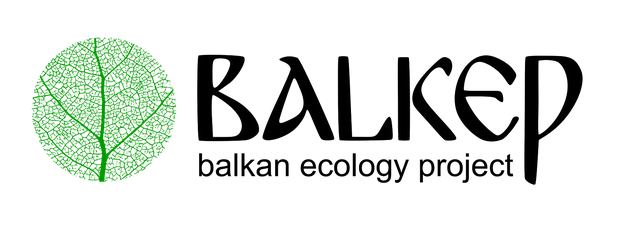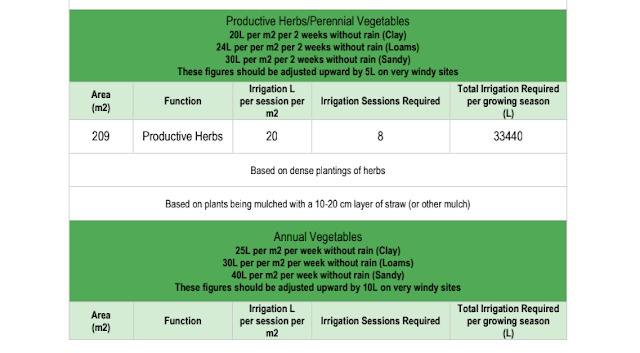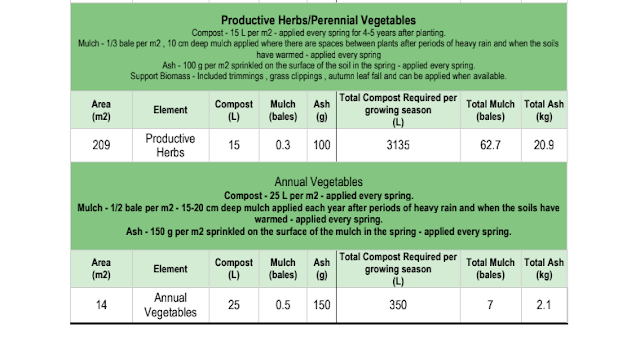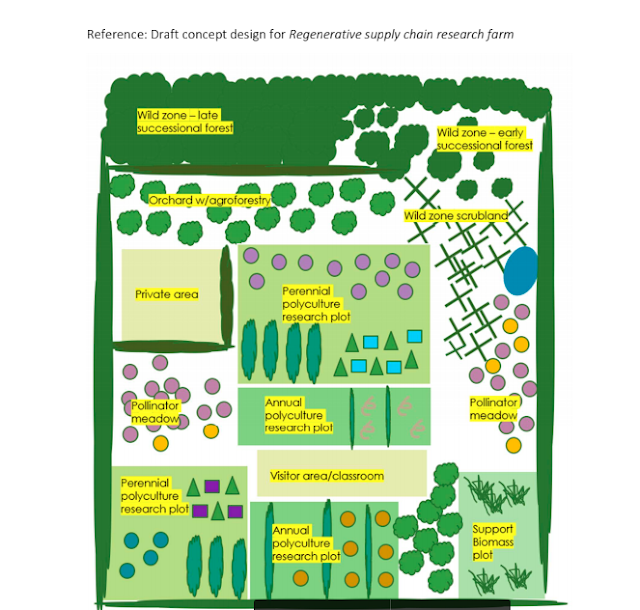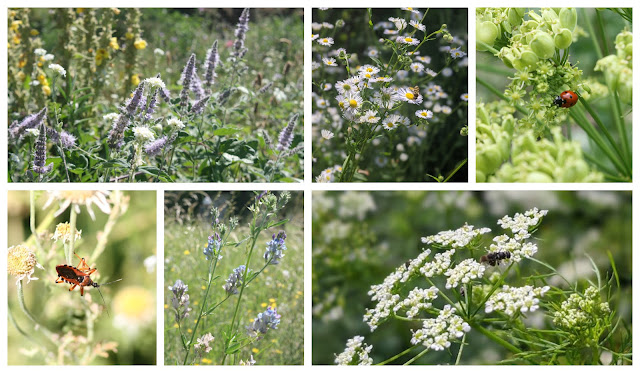All organisms are beneficial, and at the very least all organisms past, present and future decompose to nourish
something else, but when we speak of beneficial organisms we are speaking of those organisms that
provide clear and present benefits, specifically to our polyculture activity. Beneficial organisms, or Borgs as we like to call them, provide benefits to our activity of growing the stuff we need.
They seem
to be happy to carry out these duties providing we supply (or at the very least don't destroy) suitable
living conditions for them, i.e, habitat. The benefits these organisms offer come mainly in the form of increasing the productivity of our crops via pollination support, protecting our crops from pests via pest predation and providing fertility to our
crops via their roles in decomposing organic matter and supplying nutrients, fertility provision.

In this post, we're identifying some of the plants whose flowers are total Borg magnets. All the plants mentioned in this post with the exception of one are in the Umbelliferous or Apiaceae family, whose flower heads readily attract large numbers of Borgs and appear to drive them into something of a frenzy! Some of these flower heads are edible to humans, and others deadly poisonous, but all are shaped like an umbrella. The curved flower stems and flower buds are essentially clustered in yet another small umbrella, and this structure allows Borgs easy access to forage. It's not just this that pulls in the punters though - insects looking for a mate find love in the umbels, and predators take advantage of this busy meeting space.
Fennel - Foeniculum vulgare
We've put this plant a the top of the list because it's a firm favourite, with both humans and insects alike. Year on year we're amazed at the sheer volume of visiting organisms to its blooms. Famous for its aniseed flavour, the bright green feathery leaves of Fennel make a delicious addition to the salad bowl and a fine cup of tea, blending particularly well with
Lemonbalm - Melissa officialis. It grows wild in our region, and can be found growing on the road sides and in abandoned plots.
Overview: Fennel is a perennial growing as big as 1.5m high and in USDA hardiness zone 3 - 10. Over time it develops a long taproot, helping it to tolerate both drought and wind. The species is hermaphrodite and once in flower from July -September the show really starts. Prefers full sun and tolerates most soil types.
Beneficial Organisms Attracted: All manor of flies, beetles, bees, wasps and ants are attracted to the small and delicate yet bright yellow flowers that form in clusters. A 2-year
sampling campaign (Skaldina, 2020) identified an impressive 60 insect species from 40 genera across 20 families and four orders: Hymenoptera (social bees), Diptera (flies), Coleoptera (beetles) and Neuroptera (net winged insects). These orders include insects that are known to play a vital and beneficial role in ecosystem support. Fennel seeds are delicious, and the birds feasting are a good indicator of when to start harvesting them for use in the kitchen.
Want to learn more about Regenerative Landscape Design? Join The Bloom Room!
The Bloom Room is designed to create a space for more in-depth learning, for sharing projects and ideas, for seeking advice and discovering opportunities.
Ultimately, it aims to build a more intimate, interactive, and actionable relationship between members, a way for the Bloom Room community to support each other’s projects and learning journeys, and to encourage and facilitate the design, build, and management of more regenerative landscapes across our planet.
What you can expect as a member of the Bloom Room
As a member of the Bloom Room you can expect;
Access to an interactive forum where you can ask questions, direct what type of content you would like to see as well as share your own content and projects.
Monthly live session featuring general Q&A and tutorials on design software for creating and presenting polycultures.
Live session every month for members to showcase your projects, plans, designs, and gardens, with guest speakers from the community.
Full Access to all of the content on Substack
Future opportunities to join our Global Regenerative Landscape Design and Consultancy Service, with potential roles for those with the will and skill to join our design team.
An opportunity to take part in the group ownership of a Regenerative Landscape. You will find more details on that here.
Become a paid subscriber to our Substack to join. The annual subscription is currently $70 and the monthly subscription is $7 (monthly subscription excludes discounts for products and services) . You can join here, we look forward to meeting you!
Garlic Chives - Allium tuberosum
This perennial herb not only tastes great but looks great too. It's a lesser well known Allium than Chives, but arguably as delicious. The bodacious flowers are a delicate white and quite delicious. Being from the Allium family, it is said to be a good companion plant in the garden confusing many pests with their strong aroma. The plant has many medicinal properties including the leaves and bulbs used on bites, cuts and wounds.
Overview: Garlic chives is a bulb growing to 0.3m and in USDA hardiness zone 4 - 8. The species is hermaphrodite and the delicate white blooms make an interesting and tasty garnish for a salad, appearing in July - September. Prefers full sun and tolerates drought. Easily grown and with excellent polyculture potential.
Beneficial Organisms Attracted: It's not unusual to spot a wide variety of butterflies - the majority of whom are beneficial pollinators - on the flowers, including Skippers and Common Grass Blues. We've observed a wide variety of flies including several species of hoverflies, and many species of bees, including honey bees. Some predator insects, such as the crab spider - Diaea evanida have been observed tucking into a fly on the flowers, and another regular visitor recorded is the Assassin Bug - Reduviidae. that eat a wide variety of small to medium-sized insect prey including caterpillars, leafhoppers, other bugs, and aphids. They also feed on beneficial species such as lacewings.
Heracleum sphondylium - Hogweed
The name of this wildflower, perhaps unsurprisingly, comes from its reputation as being excellent pig fodder and having kept pigs before we can confirm that they do really enjoy it. It is worth noting that this plant can often be mistaken for the very poisonous Giant Hogweed - Heracleum mantegazzianum, and although there are differences in height and leaf shape, caution should be exercised. The umbels of H.sphondylium can be up to 20cm across with clusters of small white, yellow or even pinkish flowers.
 |
| Heracleum sphondylium - an excellent plant for invertebrate diversity. |
|
Overview: Hogweed is a Biennial/perennial growing to 1.8 m high and in USDA hardiness zones 4 - 8. It's very easily grown, and it's leaves grow densely together. The species is hermaphrodite and once in flower in June - September the bees start to arrive in high numbers. Can tolerate full sun or partial shade and tolerates most soil types.
Beneficial Organisms Attracted: Hogweed could probably give Fennel a run for its money in terms of how many insects it attracts. The blooms are literally smothered in flies, particularly hoverflies. There are hundreds of species of hoverflies and this group are some of the most reliable pollinators. Some species act as both pollinator and pest predator but perhaps their greatest feature is that they are not deterred by bad weather and will go about the business of pollination when many other pollinators are kicking back waiting for the sun to come out. Beetles, bees, wasps and ants join the party, attracted to the nectar and pollen, and who like to use the blooms for courtship purposes! See
this blog post for some lovely snaps of insect activity on Hogweed flowers.
Regenerative Landscape Design - Online Interactive Course
Want to learn how to design, build and manage regenerative landscapes? Join us on our Regenerative Landscape Design - Online Interactive Course. We look forward to providing you with the confidence, inspiration, and opportunity to design, build and manage regenerative landscapes, gardens, and farms that produce food and other resources for humans while enhancing biodiversity.
You can find the course details here and at the moment we have a $350 ( 20%) discount for full enrollment to the course. Just use RLD2024 in the promo code section of the registration form to receive your discount.
Conium maculatum - Hemlock
This plant is very toxic to humans and other domesticated animals such as sheep, cattle and horses. The death of Socrates in 399 BCE, as reported by Plato in the Phaedo, is usually attributed to poisoning with common hemlock. It's recorded that he was sentenced to death by drinking a deadly Hemlock concoction. Hemlock flowers play an important role in attracting pollinators and are small, white and loosely clustered, blooming in June - July. A hardy plant capable of living in a variety of environments although it dislikes acidic soil and deep shade.

Overview: Hemlock is a Biennial growing to 2m in height, USDA hardiness zone4 - 8. Stems are smooth, green and hollow, usually spotted or streaked with red or purple on the lower half . The species is hermaphrodite and flowers appear in early - mid summer. Prefers full sun and tolerates most soil types.
 |
A section of our forest garden including productive plants, biomass plants, plants for fertility and plants for beneficial insects, including Hemlock
|
Beneficial Organisms Attracted: The nectar of the flowers attracts a wide variety of flies, aphids, beetles, sawflies, and parasitoid wasps. This is a large group of insects with many different families. Most parasitic wasps are tiny, black, and less than an eighth of an inch long, and as such are frequently overlooked. These wasps do not sting. Parasitic wasps attack aphids, many types of caterpillars, cicadas, lace bugs, scale insects, whiteflies, sawfly larvae, ants, leafminers, and insect pupae. They also attack the eggs of insects such as codling moths, tomato hornworms, cabbage loopers, imported cabbage worms, and European corn borer and so play a vital role in natural pest control.
 |
| Ichneumnonidae, a parasitic wasp on Euphorbia cyparissias - Cypress spurge - Photo by Peter Alfrey |
Lovage - Levisticum officinale
Lovage as a kitchen herb isn't up there generally, but here in Bulgaria it is frequently used to flavour soups and stews, and also goes wonderfully well with fish. An easily grown plant, it prefers a rich moist but well-drained soil in a sunny position although it does tolerate partial shade and can therefore be incorporated into layers of a forest garden design as understory ground cover. Bright yellow flowers bloom in July - August and attract a lot of interest among the Borg community.

Overview: Lovage is a Perennial growing to 1.8m in height, USDA hardiness zone 5 - 9. The species is hermaphrodite and flowers appear in early - mid summer, attracting a lot of attention in the insect world. Can tolerate most soil types and has rhizomatous roots, with underground stems sending roots and shoots along their length.
Beneficial Organisms Attracted: Lovage flowers attract beneficial pest predators such as parasitic wasps and lacewings, ladybugs, numerous other flies and bees, especially honey bees. Tachinid flies love Lovage blooms, and all tachinid flies are parasitoids in their larval stage assisting with pest control. They will often visit flowers to feed too, and thus serve as pollinating agents to the garden. Butterflies are also very attracted to Lovage flowers, and hoverflies turn up in significant numbers.
Disclaimer: To the best of our knowledge all the information contained in our pages is accurate, however we cannot accept responsibility for any adverse affects that any person or animal may suffer as a result of information used in these pages. Please take time to identify and research a plant thoroughly before using.
We are offering seeds from 7 different species of plants that attract beneficial organisms in our
Perennial Plants for Beneficial Insects multi pack. These plants can be used to fill spaces between fruit trees on sunny edges attracting beneficial insects such as pollinators and pest predators.
Here are a few more of our favourite plants to attract Borgs:
Support Our Project
If you appreciate the work we are doing you can show your support in several ways.
References
http://mretcllc-mrgardens.blogspot.com/2015/04/herb-profile-lovage-and-caraway.html
https://www.hindawi.com/journals/ijecol/2013/237457/
Skaldina, O. Insects associated with sweet fennel: beneficial visitors attracted by a generalist plant. Arthropod-Plant Interactions 14, 399–407 (2020). https://rdcu.be/cgBmm

